15 Service Blueprinting
Service Blueprinting
Service blueprinting is a powerful technique used in service design and management to visualize the entire service process. Developed in the early 1980s, this method has evolved to become an essential tool for service organizations seeking to improve their operations and customer experiences.
At its core, service blueprinting is a diagram that displays the entire service process, the points of customer contact, and the evidence of service from the customer’s perspective. Unlike other process mapping techniques, service blueprinting places a strong emphasis on the customer and their interactions with the service provider, making it particularly valuable in today’s customer-centric business environment.
The importance of service blueprinting lies in its ability to provide a comprehensive view of both the front-stage and back-stage elements of a service. This holistic perspective allows organizations to identify inefficiencies, improve coordination between different departments, and enhance the overall customer experience.
Key Components of a Service Blueprint
A service blueprint consists of five key components, represented by row on a chart, each representing a different aspect of the service delivery process:
- Customer Actions: These are the steps, choices, activities, and interactions that the customer performs in the process of purchasing, consuming, and evaluating the service.
- Onstage/Visible Contact Employee Actions: These are the actions of frontline service employees that occur directly in view of the customer.
- Backstage/Invisible Contact Employee Actions: These are the actions of employees that occur behind the scenes to support the onstage activities.
- Support Processes: These are the internal steps and interactions that support the employees in delivering the service.
- Physical Evidence: This includes all the tangible elements that customers see, hear, smell or touch throughout their service experience.
For example, in a restaurant service blueprint:
- – Customer actions might include entering the restaurant, being seated, ordering food, eating, and paying the bill.
- – Onstage actions would involve the host greeting and seating customers, and the waiter taking orders and serving food.
- – Backstage actions could include the chef preparing the meal and the dishwasher cleaning plates.
- – Support processes might involve the inventory management system and the reservation software.
- – Physical evidence would include elements like the menu, the decor, and the food presentation.
Lines in Service Blueprinting
Service blueprints are characterized by several horizontal lines that separate different areas of action and interaction. These lines are crucial in understanding the structure and flow of the service process:
Line of Interaction: This is the topmost line in a service blueprint. It represents the direct interactions between the customer and the organization. Everything above this line consists of customer actions, while everything below involves actions by the service provider.
For example, in a retail store, the point where a customer hands over their credit card to a cashier would be represented on the line of interaction.
Line of Visibility: This line separates all service activities that are visible to the customer from those that are not. Above this line are the onstage actions performed by customer-facing employees. Below are the backstage actions that customers do not see.
In a restaurant setting, the line of visibility would separate the dining area (visible) from the kitchen (invisible to the customer).
Line of Internal Interaction: Also known as the line of internal visibility, this separates contact employees from those who are in support roles. It distinguishes backstage actions from support processes.
In a hotel, this line might separate the concierge’s behind-the-scenes work (backstage) from the activities of the housekeeping scheduling system (support).
These lines serve several important purposes in a service blueprint:
- They help clearly delineate different types of activities and processes within the service delivery system.
- They highlight the visibility of various service elements to the customer, which can be crucial in managing customer perceptions and expectations.
- They assist in identifying points where the service might be particularly vulnerable to failure, especially at the intersections between different zones.
- They aid in understanding the complexity of the service process and the level of coordination required between different parts of the organization.
For instance, in an e-commerce service blueprint, the line of interaction might represent the customer’s engagement with the website interface. The line of visibility could separate the website (visible) from the order processing system (invisible). The line of internal interaction might distinguish the order fulfillment team from the inventory management system.
Benefits of Service Blueprinting
Service blueprinting offers numerous advantages to organizations:
- Visualizing the entire service process: By mapping out all aspects of the service, both visible and invisible to the customer, organizations can gain a comprehensive understanding of their service delivery.
- Identifying potential failure points: The detailed nature of service blueprints allows companies to spot areas where the service might break down or where customer dissatisfaction might occur.
- Improving cross-functional collaboration: Service blueprints provide a common language and visual representation that can help different departments understand their role in the overall service delivery.
- Enhancing efficiency and reducing costs: By clearly showing all processes involved in service delivery, blueprints can help identify redundancies or unnecessary steps, leading to more streamlined operations.
- Driving innovation in service design: The holistic view provided by service blueprints can inspire new ideas for service improvements or entirely new service offerings.
For example, a bank using service blueprinting for its loan application process might identify that customers often struggle with gathering necessary documentation. This insight could lead to the development of a digital document upload feature in the bank’s mobile app, streamlining the process for customers and reducing workload for employees.
Service Blueprinting vs. Customer Journey Mapping
While both service blueprinting and customer journey mapping are valuable tools in service design, they have distinct characteristics:
- Focus: Service blueprinting is process-oriented, detailing the operational aspects of service delivery. Customer journey mapping is experience-oriented, focusing on the customer’s emotions and perceptions.
- Scope: Service blueprints encompass both internal and external processes, while journey maps primarily focus on the customer’s external interactions with the brand.
- Level of detail: Service blueprints provide operational detail, including backstage processes. Journey maps emphasize emotional and experiential details from the customer’s perspective.
- Primary use: Service blueprinting is typically used for service design and operational improvement. Customer journey mapping is often employed for enhancing the overall customer experience and informing marketing strategies.
Conclusion
Service blueprinting stands as a crucial tool in modern service management, offering a comprehensive method to visualize, analyze, and improve service processes. By providing a clear picture of both customer-facing and behind-the-scenes activities, it enables organizations to enhance their service delivery, improve efficiency, and ultimately deliver better customer experiences.
Example of Service Blueprints
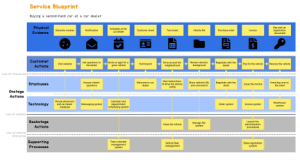
https://draft.io/example/service-blueprint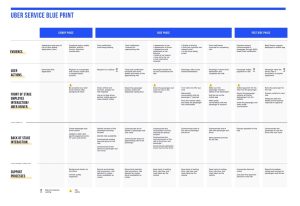 https://servicedesigntools.org/tools/service-blueprint
https://servicedesigntools.org/tools/service-blueprint
The following examples are all taken from this blog post: https://www.smaply.com/blog/service-blueprints
Service blueprint example from healthcare/pharmacy
Service blueprint for a pharmacy
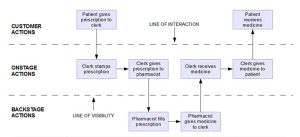
Example of a service blueprint from healthcare
Service blueprint for a hospital
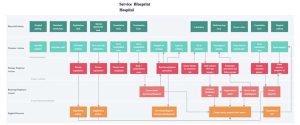
Example of a service blueprint from finance / loans
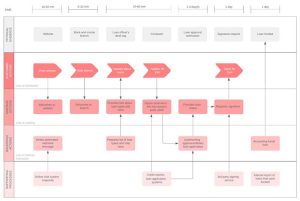
Example service blueprint from hospitality: a cafeteria’s processes
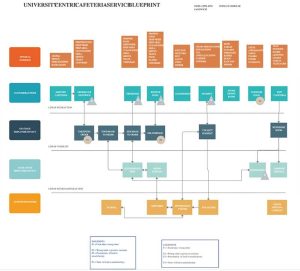
Media Attributions
- 15-1
- 15-2
- 15-3
- 15-4
- 15-5
- 15-6
